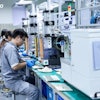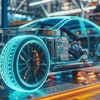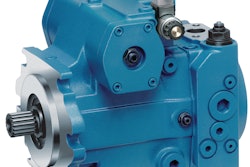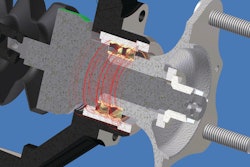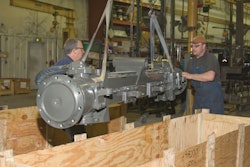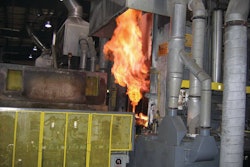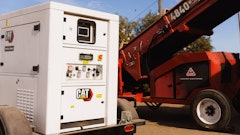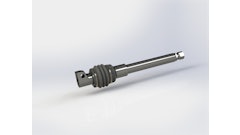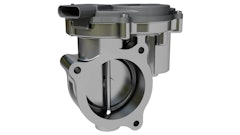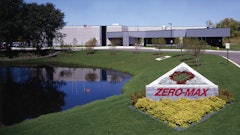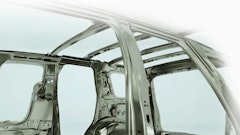If there's one thing equipment users want to avoid, it's machine downtime, even to lubricate a joint. When industrial vehicles are down, they aren't making their owners any money. And, if a machine is down for a difficult repair, the situation actually reduces the owner's bottom line. One such time-consuming (and costly) repair is bearing replacement.
GGB Bearing Technology, Chadds Ford, PA, has developed a new sealed bearing cartridge (SBC) to give off-road OEMs an alternative to conventional greased bronze, hardened steel and rolling-element bearings for demanding applications.
"The accelerated wear with commonly used steel bushings can cause a major maintenance problem in the equipment's pivot joints," Charles Woods, global product manager, explains. "Our SBC solves this problem and can save the equipment owner real time and money."
The savings come because the equipment does not have to be taken out of operation to be serviced. "The cost of a lubrication system is eliminated and maintenance labor costs are reduced," he says. "Plus, the equipment owner does not have to use a potentially environment-harmful lubricant or worry about spills."
Developed with customer input
GGB, formerly known as Glacier Garlock Bearings, has been developing the new sealed bearing cartridge for about two years.
"We've worked with off-highway OEMs for many years, and we designed the SBC based on their desire to solve key mechanical maintenance issues plaguing their end users," Woods says. "One of the most common metal wear and maintenance problems for off-road equipment owners is pivot points. SBC was developed to solve that problem."
The company cites typical applications for the SBC bearing would include dump body pivots, critical clearance joints, linkage pins, lift cylinders, articulating joints, steering cylinders, suspension or track trunnions and king pins.
The new sealed bearing cartridge is based on GGB's Gar-max filament wound bearing. "This has long been the industry standard for grease-free bearings for high-load, oscillating applications," he points out. "Its strength, combined with the SBC's durable lip seal that excludes debris, enables the OEM to provide a maintenance-free solution. This can help reduce warranty claims and provides a market advantage of reducing the end customer's total cost of ownership."
He says GGB's filament-wound bearings have a bearing surface of PTFE and high-strength fibers twisted together and encapsulated by a high temperature epoxy resin that has been further enhanced with a self-lubricating additive. High-load capability is up to 90,000 lbs./sq. in. or 620 MPa. The bearings exhibit good tolerance to shock and edge loading, as well as dimensional stability due to no water absorption (no swelling).
Rigorous testing
GGB worked with major off-highway OEMs and the Advanced Manufacturing Institute (AMI) at Kansas State University to prove that its SBC out-performs greased, hardened-steel bearings.
AMI is a department in the college of engineering at Kansas State. Its mission is to provide an array of resources to people and companies about advanced technologies. "We do this through collaborative engineering and business partnerships," Taylor Jones, chief engineer, explains. "We accomplish our mission by utilizing our engineering expertise to develop and transfer new technologies, as well as providing technical assistance to industry."
AMI had a customer company looking for alternative solutions for pin joints in abusive applications, so the institute developed a test plan to evaluate what was currently on the market. This included greased hardened steel bushings, chrome-plated pins and different bearing materials. During the process, AMI contacted various suppliers, including GGB.
"Field tests could take a year or two to get conclusive results," Jones says, "so we developed a way to accelerate the test in the lab. As part of this trial, we tested the GGB sealed bearings for three months against traditional greased hardened-steel bushings."
The test conditions simulated an abusive field application and heavy contamination by combining sand, dirt and water into a thick paste. "Most lab tests use a 'mud box' but the contaminant can wick away during oscillating and rotating test cycles," he explains. "In our test, we wanted to simulate a machine that is constantly in and out of the contamination all day long. We applied the paste right on the bearing."
The tests also focused on conditions with bearing working pressures up to 7,500 psi, oscillating motion speeds that averaged 20 degrees/second and roughly 575 cycles per hour. A baseline test determined the duration of the GGB sealed bearing test.
"It provided lab-to-field correlation and comparative results," he recalls. "The test rig was capable of testing four components simultaneously, which we believed was enough data points to compare the SBC's overall performance against the sealed, greased hardened-steel bushing."
The results
The average wear of the SBC was 0.003 in., as compared to an average wear of 0.022 in. for the traditional bushing, though the SBC was tested about 2.5 times longer than the greased hardened-steel bushing (600,000 cycles compared to 220,000 cycles).
"If properly sealed, the nongreased GGB sealed bearing cartridge bearing appears to be a viable alternative to a sealed and greased hardened-steel bushing in severe work environment," Jones says. "Any designer using the SBC in its equipment should follow GGB's recommended design practices for a successful solution."
Woods points out that an outer steel casing on the SBC helps with its installation and durability of the bearing cartridge. "This is especially true in applications where you have impact and edge loads that can damage the bearing. We found it makes for a more durable unit," he says.
Woods concludes, "The GGB sealed bearing cartridges offer significant benefits because they're high-strength, self-lubricating bearings with integral sealing. Greasing is not required, resulting in an 'environmentally friendly' product. This produces substantial bearing life improvement with significant system cost savings compared to other types of bearings."
